NDVI stands for "Normalized Difference Vegetation Index". NRG stands for "Near-infrared / Red / Green". NDVI and NRG are both ways to visualize the amounts of infrared and other wavelengths of light reflected from vegetation. Because both these methods compare ratios of blue and red light absorbed versus green and IR light reflected, they can be used to evaluate the health of vegetation. It's a snapshot of how much photosynthesis is happening. This is helpful in assessing vegetative health or stress. (Read more here: https://www.agronomy.org/publications/jeq/articles/36/3/832) ## Do-It-Yourself These techniques for vegetation analysis were developed for satellite imagery, but at Public Lab, we've been working a lot on capturing infrared imagery using our DIY [near-infrared camera](/wiki/near-infrared-camera) setup, and combining it with visible bands to produce NDVI images such as the one above. ## What these images mean What exactly are these images we're trying to make? What do they tell us about vegetation, and why? These diagrams should help to understand what it is we're doing and why these are good ways to analyze plant life. ## The NDVI equation [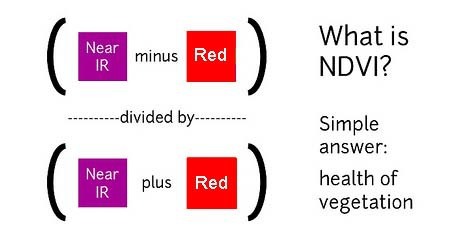](/i/44723) **NDVI = (Near Infrared - Red)/(Near Infrared + Red)** NDVI is a ratio which tries to emphasize photosynthesis while filtering out sun glare. The above equation is run for every pixel, using source data from an infrared photo and a visible light photo, like this pair: [](https://publiclab.org/system/images/photos/000/021/771/original/5390895115_c9d4d38fec_o.jpg) The result can be false-colored to make the high-photosynthesis areas more clear, and used to examine where plants are and how healthy they are. [](https://publiclab.org/system/images/photos/000/021/770/original/PetVISNDVIcomp.png) _Figure above: Normal color photo (right) and normalized difference vegetation index (NDVI) image (left). NDVI image was derived from two color channels in a single photo taken with a camera modified with a special infrared filter. Note that tree trunks, brown grass, and rocks have very low NDVI values because they are not photosynthetic. Healthy plants typically have NDVI values between 0.1 and 0.9. -- @cfastie_ ### Activities Here are a range of activities you can do to produce and interpret your own NDVI imagery, whether downloaded from a satellite imagery provider or [collected yourself using a DIY technique](/wiki/multispectral-imaging) [activities:ndvi] ****   Most DIY converted cameras today (those from Public Lab) use RGN instead of NRG, so the blue channel represents infrared instead of the red channel. That looks like this: [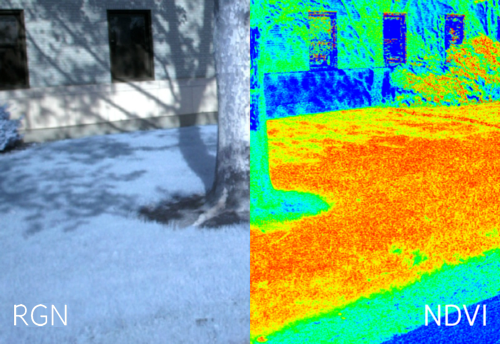](/i/45468?s=o) **** ## NRG imagery Some people are also interested in producing NRG imagery (like the below image), where `Near-Infrared, Red, and Green` are used to compose a picture instead of the usual `Red, Green, and Blue`. [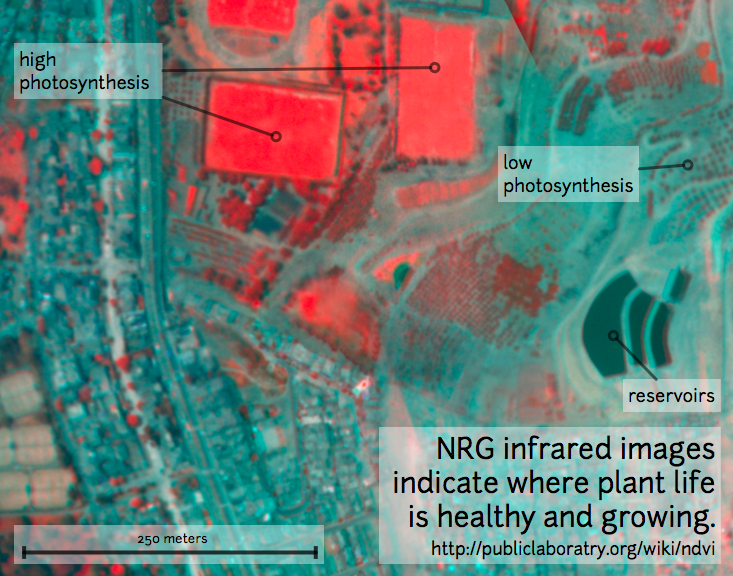](/i/25064) This diagram explains the swapping, which allows us to 'see' infrared as if it were a normal color: [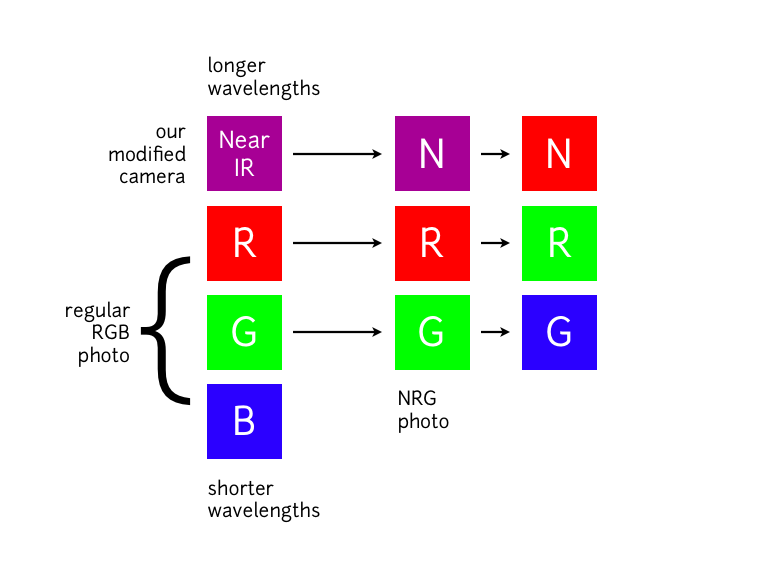](/i/25063) **In NRG images, the deeper and clearer the red color, the denser and healthier the vegetation (more or less).** ### Questions [questions:ndvi] ### Other examples of DIY NDVI imaging From around the internet: Begin watching at 2 minutes to see the resulting imagery: *This topic is part of the [Grassroots Mapping Curriculum](/wiki/mapping-curriculum) series.* **** [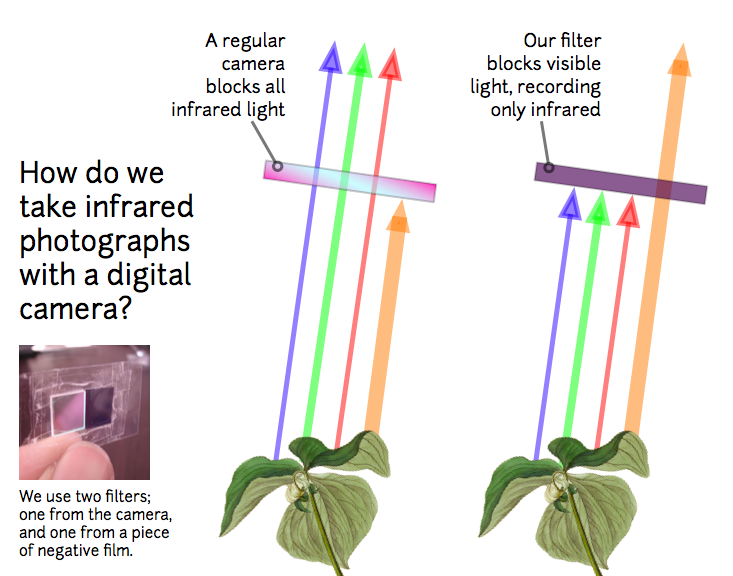](/i/25066) [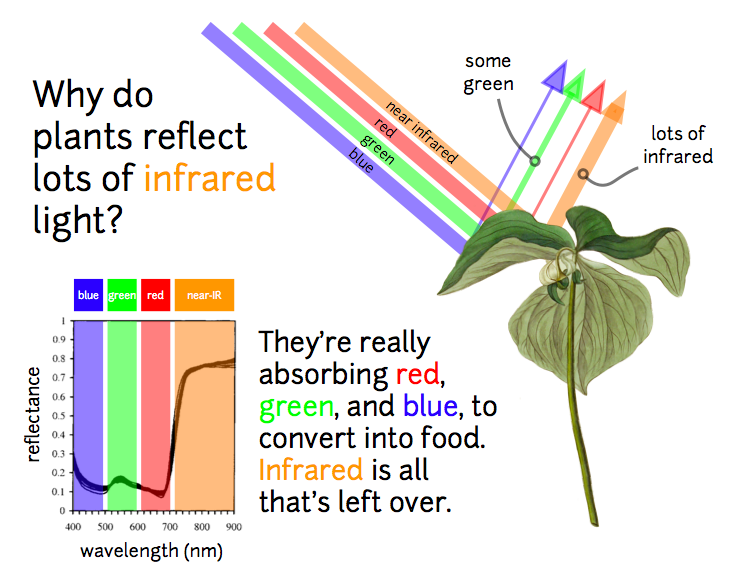](/i/25065) ...
| Author | Comment | Last activity | Moderation | ||
|---|---|---|---|---|---|
| nedhorning | "Several years ago I was thinking of how to build a DIY integrating sphere/monochromator setup but never pursued it. You would want something other ..." | Read more » | about 9 years ago | |||
| JacobNederend | "http://www.int-arch-photogramm-remote-sens-spatial-inf-sci.net/XL-1-W4/207/2015/isprsarchives-XL-1-W4-207-2015.pdf This paper has a method for det..." | Read more » | about 9 years ago | |||
| nedhorning | "The current version of the plugin only outputs index (NDVI and DVI) images. The plugin only calibrates two bands, a visible and a NIR band and two ..." | Read more » | about 9 years ago | |||
| JacobNederend | "Thanks for the feedback. I think I misunderstood the function of this plugin. I thought I could calibrate my jpeg R/G/NIR images to a black, a gre..." | Read more » | about 9 years ago | |||
| nedhorning | "Hi Jacob, To check for aperture you could try another EXIF reader. Maybe "max aperture" is the same as "aperture" but I have no idea. When working ..." | Read more » | about 9 years ago | |||
| JacobNederend | "Hi Ned, I am really excited about the work you are doing here as it helps resolve some major issues with my grad studies. I have a few questions: ..." | Read more » | about 9 years ago | |||
| nedhorning | "Chris - The relationships are curvilinear but my preference is to try and figure out how to "correct" the JPEG pixel values to create a linear rel..." | Read more » | about 9 years ago | |||
| cfastie | "Ned, So the displayed graphs with two points are not meaningless (I found them to be helpful), but the R² values are not useful because they are a..." | Read more » | about 9 years ago | |||
| nedhorning | "Hi Cindy - I'll start with the easy question first. The user guide can be downloaded from the plugin's GitHub repository: https://github.com/nedhor..." | Read more » | about 9 years ago | |||
| cindy_excites | "Hi! Very exciting note! Thanks for sharing. Just wondering, could you expand a little more on "When the calibration coefficients are calculated a g..." | Read more » | about 9 years ago | |||
| mathew | "you may want to connect with @John_Wells and the West Lothian Archaeological Society about filters for identifying underground features. They've b..." | Read more » | about 9 years ago | |||
| cfastie | "A couple of comments ago I included NDVI images from infragram.org and Fiji that are essentially the same. This sort of confirms that infragram.org..." | Read more » | about 9 years ago | |||
| mathew | "i agree with chris. infragram.org doesn't reflect current best practices or our research interests either, as ned continues to advance calibration..." | Read more » | about 9 years ago | |||
| cfastie | "The link above to the Python code for converting photos to NDVI images is not a link at Public Lab. However, a version of this Python code is avail..." | Read more » | about 9 years ago | |||
| cfastie | "Thanks wmaiouiru, that's a good point. All three NDVI images use a different color map. I don't know what the Python code image uses for a color ma..." | Read more » | about 9 years ago | |||
| rahulrajias | "is it possible to operate/connect 2 pi cameras simultaneously with one pi ??? " | Read more » | about 9 years ago | |||
| wmaiouiru | "Are those three NDVI using the same color map? Perhaps an option to create NDVI without the colormap might clear things up a bit. " | Read more » | about 9 years ago | |||
| liz | "Great framing Chris, thank you. I have the same question " | Read more » | about 9 years ago | |||
| cfastie | "Correct. If the Wratten 25A camera requires exposures that are too long, you can just shoot normal photos and use the red channel for VIS (so don't..." | Read more » | about 9 years ago | |||
| Steven | "Ok, so if I understand you correctly, using a standard PiCam with the IR filter un-removed and a Wratten 25A filter added to the PiCam, while takin..." | Read more » | about 9 years ago | |||
| cfastie | "If you use the Fiji plugin to make NDVI, you will not need the techniques in the video above. The plugin does the comparison of NIR and VIS for eac..." | Read more » | about 9 years ago | |||
| Steven | "Thanks, that's helpful . Yes, it is possible to operate two PI cameras from one Pi (though I'm still sorting through the debate/speculation about t..." | Read more » | about 9 years ago | |||
| cfastie | "Can you operate two Pi cameras from one Pi? If so, you should be able to trigger the shutters simultaneously which is important. The Pi NoIR could ..." | Read more » | about 9 years ago | |||
| Steven | "Yes, a long exposure wouldn't be practical because of the instability of the platform the camera would be on (cost is also a limiting factor). My t..." | Read more » | about 9 years ago |